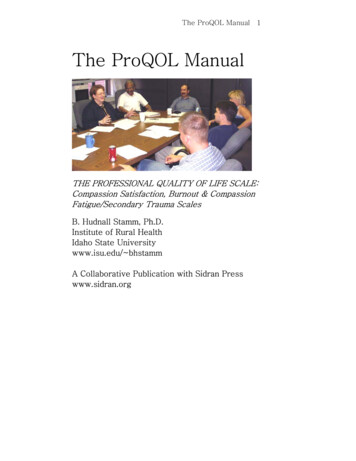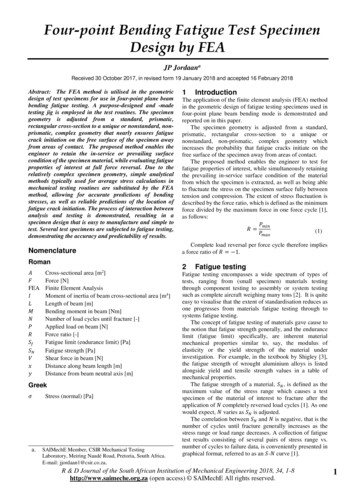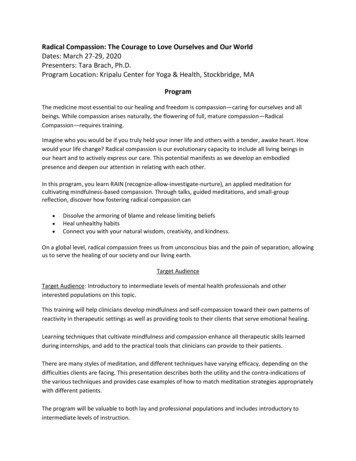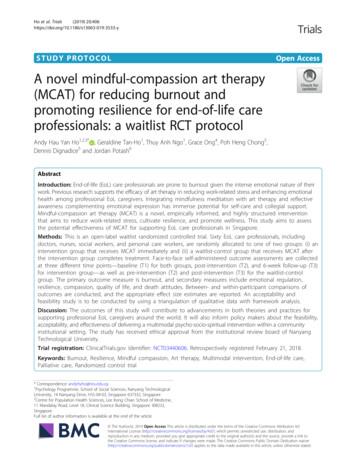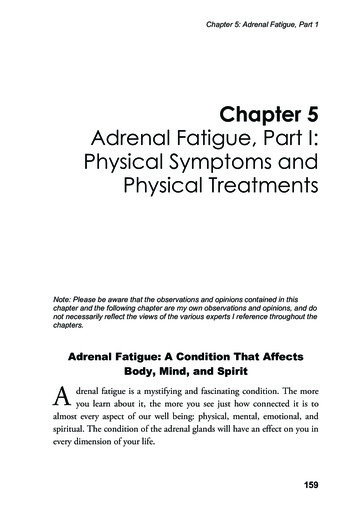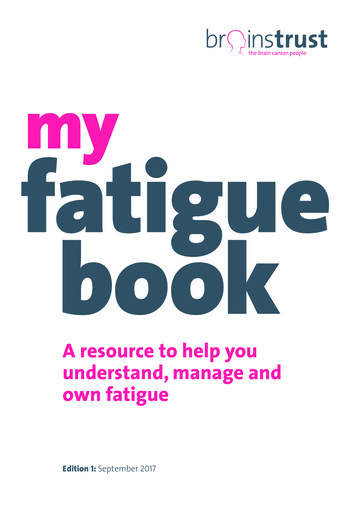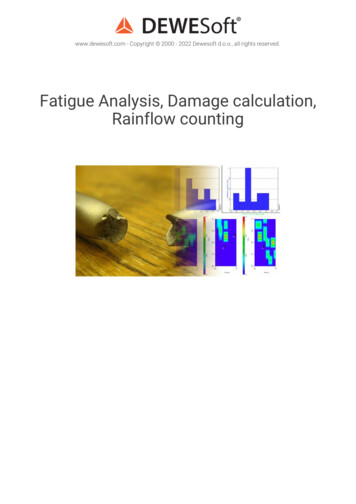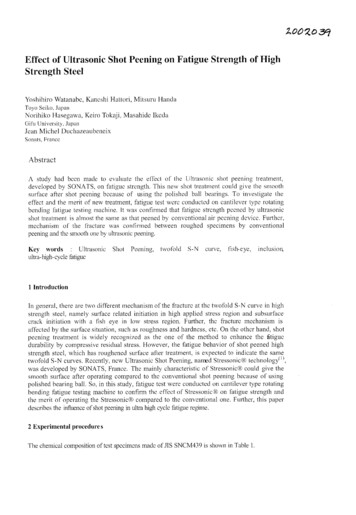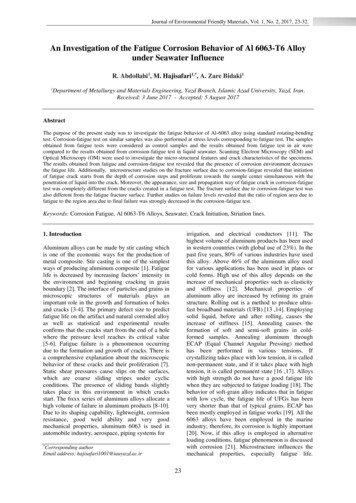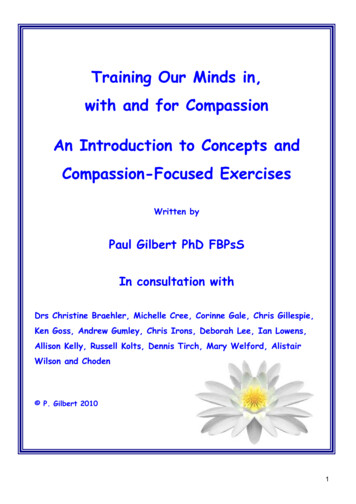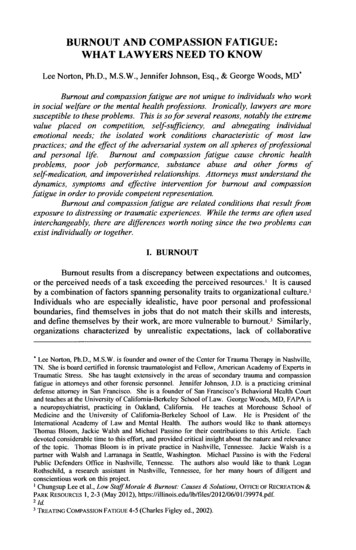
Transcription
BURNOUT AND COMPASSION FATIGUE:WHAT LAWYERS NEED TO KNOWLee Norton, Ph.D., M.S.W., Jennifer Johnson, Esq., & George Woods, MD*Burnout and compassionfatigue are not unique to individuals who workin social welfare or the mental health professions. Ironically, lawyers are moresusceptible to these problems. This is sofor several reasons, notably the extremevalue placed on competition, self-sufficiency, and abnegating individualemotional needs; the isolated work conditions characteristic of most lawpractices; and the effect of the adversarialsystem on all spheres of professionaland personal lfe.Burnout and compassion fatigue cause chronic healthproblems, poor job performance, substance abuse and other forms ofself-medication, and impoverished relationships. Attorneys must understandthedynamics, symptoms and effective intervention for burnout and compassionfatigue in order to provide competent representation.Burnout and compassion fatigue are related conditions that result fromexposure to distressing or traumatic experiences. While the terms are often usedinterchangeably, there are differences worth noting since the two problems canexist individually or together.I. BURNOUTBurnout results from a discrepancy between expectations and outcomes,or the perceived needs of a task exceeding the perceived resources.' It is causedby a combination of factors spanning personality traits to organizational culture.2Individuals who are especially idealistic, have poor personal and professionalboundaries, find themselves in jobs that do not match their skills and interests,and define themselves by their work, are more vulnerable to burnout.3 Similarly,organizations characterized by unrealistic expectations, lack of collaborative&* Lee Norton, Ph.D., M.S.W. is founder and owner of the Center for Trauma Therapy in Nashville,TN. She is board certified in forensic traumatologist and Fellow, American Academy of Experts inTraumatic Stress. She has taught extensively in the areas of secondary trauma and compassionfatigue in attorneys and other forensic personnel. Jennifer Johnson, J.D. is a practicing criminaldefense attorney in San Francisco. She is a founder of San Francisco's Behavioral Health Courtand teaches at the University of California-Berkeley School of Law. George Woods, MD, FAPA isa neuropsychiatrist, practicing in Oakland, California. He teaches at Morehouse School ofMedicine and the University of California-Berkeley School of Law. He is President of theInternational Academy of Law and Mental Health. The authors would like to thank attorneysThomas Bloom, Jackie Walsh and Michael Passino for their contributions to this Article. Eachdevoted considerable time to this effort, and provided critical insight about the nature and relevanceof the topic. Thomas Bloom is in private practice in Nashville, Tennessee. Jackie Walsh is apartner with Walsh and Larranaga in Seattle, Washington. Michael Passino is with the FederalPublic Defenders Office in Nashville, Tennesse. The authors also would like to thank LoganRothschild, a research assistant in Nashville, Tennessee, for her many hours of diligent andconscientious work on this project.' Chungsup Lee et al., Low StaffMorale & Burnout: Causes & Solutions, OFFICE OF RECREATIONPARK RESOURCES 1, 2-3 (May 2012), .2IdTREATING COMPASSION FATIGUE 4-5(Charles Figley ed., 2002).
UMKC LAW REVIEW988[Vol. 84:4work teams, and an inability to recognize and address individual and collectiveneeds create a greater likelihood of burnout. 4These traits lead to "closedsystems"-environments that foster isolation, stifle creativity, and prevent theability to assess problems in novel ways and gain access to effective resources.'Symptoms of burnout include loss of hope, avoidance of clients and colleagues,agitation and irritability, self-doubt and loss of self-confidence, cynicism, apathy,and diminished problem-solving skills.' Sufferers try to work "more and harder,"renew their commitment, and use professional and interpersonal tools that havelong lost their efficacy. 7 The universal lament of professionals who suffer fromburnout is, "I hate my job." Efforts to ease overwhelming frustration andemptiness include use of alcohol and drugs, transient relationships, and otherdistractions such as excessive spending and gambling."II. COMPASSION FATIGUECompassion fatigue results from the cumulative emotional,psychological and physical effects of exposure to the pain, distress or injusticesuffered by clients.9 Unlike burnout, which is related to work conditions,compassion fatigue has to do with the response to the content of clients' storiesand experiences. 0 Charles Figley, a pioneer in the field of compassion fatiguedescribes the phenomenon in this way:There is a cost to caring. Professionals who listen to clients' stories offear, pain, and suffering may feel similar fear, pain, and sufferingbecause they care. Sometimes we feel we are losing our sense of self tothe clients we serve . . Those who have enormous capacity for feelingand expressing empathy tend to be more at risk of compassion stress."Individuals at a high risk for compassion fatigue tend to be conscientious,perfectionist and self-giving.' 2 Other risk factors include being exposed toenvironments with low social support, high personal stress, or having4ENCYCLOPEDIA OF MENTAL HEALTH 223 (Howard S. Friedman ed., 2d ed. 2015).PHARMACEUTICAL PROCESSES 451 (James Agalloco and FrederickJ. Carleton eds.,3d ed. 2008) ("Closed systems provide for complete separation between the environment in whichpersonnel (uniformly accepted as the primary source of contamination in aseptic environments) areseparated from that in the materials are processes."). Id.6 Dennis Portnoy, Burnout and Compassion Fatigue: -Watchfor Signs, CATHOLIC HEALTH Ass'N OF THEUNITED STATES 47,47 (2011), availableat ess.pdf.7Id.8Id at 48.9 Id. at 47-48.5 VALIDATION OF10 Id." COMPASSION FATIGUE: COPING WITH SECONDARY TRAUMATIC STRESS DISORDER IN THOSE WHOTREAT THE TRAUMATIZED 1 (Charles R. Figley ed., 1995).12 PROVIDING COMPASSIONATE HEALTHCARE: CHALLENGES IN POLICY AND PRACTICE 215-16Shea, Robin Wynyard, & Christos lonis eds., 2014).(Sue
BURN OUT AND COMPASSION FATIGUE2016]989experienced significant loss or other trauma. 3 These often combine withcharacteristics of the legal profession to further heighten vulnerability tocompassion fatigue.The role of zealous advocacy forces attorneys tosubordinate their emotional response to the more objective needs of the case.14Chronic disregard of one's own feelings negatively affects social, cognitive andphysical well-being. This unavoidable lack of awareness leads to numerousproblems in all spheres of life. Cognitive symptoms include rigid, black andwhite thinking, difficulty concentrating, confusion and memory loss, loss ofsense of direction and purpose, an inability to recognize cause and effect,minimization of problems, consequences or conditions, and preoccupation withcurrent stressors that cannot be externally changed or controlled." Compassionfatigue causes or worsens many emotional symptoms as well. People complainof chronic fear and anxiety, inexplicable guilt and shame, self-doubt, withdrawaland isolation, feeling overwhelmed by small challenges, irritability and anger,powerlessness, numbness, an inability to remain engaged with and connected topeople and to areas of life not related to work, unbidden thoughts aboutwork-related events and stories, and persistent, intrusive concern about theproblems of cases, clients and others.'6Physical complaints (due largely to over-activation of the autonomicnervous system, which tells the body to produce stimulating chemicals such asadrenalin and cortisol in order to prepare for fight-or-flight) comprise a broadswath of symptoms. ' These include changes in breathing, heart rate andcirculation (many false alarms in emergency rooms are due to shortness of breathand chest pain that result from sudden changes in cortisol and adrenalinproduction versus cardiac crisis), difficulty falling or staying asleep, problemswith appetite and digestion (hunger and appetite are different; individualssuffering from stress and compassion fatigue describe feeling hungry but havingno appetite and vice versa, or eating as a means of self-soothing), headaches,decreased libido, chronic musculoskeletal pain, including burning, throbbing,tightness and piercing sensations (back pain is one of the most commoncomplaints), and immune problems, such as vulnerability to colds, allergies,viruses, ulcers, and infections."Long-term compassion fatigue undermines our convictions aboutourselves and the world. We question previously held and cherished beliefs, ourvalue to ourselves and others, the usefulness of our efforts, and the purposes towhich we have committed ourselves. Meaning-making is compromised, and weId.14 Feng-Jen"Tsai et al., OccupationalStress and Burnout of Lawyers, 51 J. OCCUPATIONAL HEALTH443,449(2009)." Peter G. Jaffe et al., Vicarious Trauma in Judges: The PersonalChallenge ofDispensingJustice,JUDGES J. 12, 15 (2006).4516Id at 16.'7Andrew P. Levin & Scott Greisberg, Vicarious Trauma in Attorneys, 24 PACE L. REv. 245, 248(2003).18 Id.
990UMKC LAW REVIEW[Vol. 84:4languish with inertia. Compassion fatigue leads to attrition and the loss ofinvaluable human resources.III. THE BIOLOGY OF BURNOUT & COMPASSION FATIGUE:HOW IT WORKSA basic understanding of the brain and nervous system helps usunderstand how burnout and compassion fatigue develop. Let's begin with thebrain. It is the most complex organ in the human body, far more sophisticatedthan any computer, and able to perform complicated algorithms simultaneously.It is divided into two halves that work together but have different jobs.1 9 The leftside of the brain is in charge of language, time, sequencing, logic, and analysis. 20The right side of the brain is as interesting for what it does not do as for what itdoes do. It has no ability to talk-it is mute. 2 1 It has no sense of time-it doesnot know if something occurred today, yesterday, or thirty years ago. As a resultit cannot put events in order; it records things in scattergun fashion. 2 2 It has anacute memory, though events are not stored verbally; they are recorded inimages, feelings and body sensations. 23 Up until recently our society hasemphasized Descartes' notion, "I think therefore I am" 2 4 and placed greaterweight upon our ability to analyze, think, and talk about our experiences. Theproblem with this strategy is it fails to listen to, and take counsel from, theenormous amount of information provided through emotions, sensations, images,impulses, and spot-on intuition that are essential to effectively interpreting andacting on our experiences. One may say, then, that the left hemisphere representsthe forest, and the right hemisphere can not see the forest for the trees.It takes both hemispheres of the brain to create a coherent understandingof our experiences. When they work together, we get the feelings, sensations,and images of events, and can interpret these and place them in the context ofthings previously learned and what is now occurring. We know what we knowand we know why. This creates explicit memory.25The left hemisphere, which is smart but slow, makes a valiant effort toanalyze, organize, and interpret overwhelming or confusing experiences. 26 ain-functions.php (last visited Nov. 6, 2015).20 Id21Id.22Id.23DANIEL GOLEMAN, Focus: THE HIDDEN DRIVER OF EXCELLENCE 28 (2013); see also LouisTINNIN, THE INSTINCTUAL TRAUMA RESPONSE AND DUAL-BRAIN DYNAMICS: A GUIDE FOR TRAUMATHERAPY 12 (2013).24 Descartes: I Think Therefore I Am, NEw LEARNING, descartes-i-think-therefore-i-am (last visited Nov. 6, 2015).2sAnne Uecker et al., NeuroanatomicalCorrelatesof Implicit and Explicit Memory for StructurallyPossible and Impossible Visual Objects, 4 Learning & Memory 337, 337-38 (1997).26See Hemisphere Brain Functions, supra note 19.
2016]BURN OUT AND COMPASSION FATIGUE991when the information exceeds the resources of the left hemisphere, it throws upits hands and goes off line, screaming help to the right hemisphere." The righthemisphere nobly comes to the rescue. A chief first-responder is the amygdala(almond), which serves as the brain's sentry and is always on the look-out fordanger (anything strange gets special scrutiny). 28 It is incisive, and works likelightening to mobilize powerful defenses. 29 It sends a distress call to otherorgans, which produce chemicals such as adrenaline (epinephrine) and cortisolthat prepare us for fight or flight.30 While this response is essential to ourAmygdala-drivensurvival (physical and psychological), there is a cost.behaviors protect us from perceived threats, but in the process we lose precisionand perspective. 3 In this mode, we have a high idle and are poised to shoot ateverything that moves; we act first and talk later (Sandy Bloom calls this "apaucity of language and a propensity to act"). 3 2Then there is the aftermath. Following this quick-response, the righthemisphere begins to wonder what exactly happened. What did all this mean? Itknocks on the door of the left hemisphere for answers. The left hemisphere says,"I'd love to help you, but I was off-line." The right hemisphere wanders off for atime, but is soon back asking the same questions. This creates a cycle in whicheach side of the brain, both eager for answers but hindered by their unhitching inthe heat of the moment, continually engage each other for answers. Stressfulevents result in implicit memories that are fragmented and disjointed.3 3 Becausethe events called for right-hemisphere dominance, we do not have a cohesivestory of what happened, with a distinct beginning, middle and end. Instead,unrelated pieces repeat themselves in an effort to bring out attention to the needfor completion. The adrenalin created an emotional brand of the feelingsassociated with the experience, primarily fear and anger. Sometimes we haveflashbulb memories of events that intrude unbidden into our consciousness andinterfere with our thoughts. And our bodies recall the tension, flushing, and otherresponses, such as myopia, increased heart rate and blood pressure, sweating,digestive changes (in fight and flight, our first response is to empty the gut andbladder and send all reserves to the heart and head), and, in extreme cases,numbness and a sense that we are not fully in our bodies. 34 We do not have acoherent account of the details of what happened and why, so we fill in theblanks with what might have happened. Much of our perceptions and beliefs27IdTHE PRAEGER HANDBOOK OF LEARNING AND THE BRAIN, VOL. 1 83 (Sheryl Feinstein ed., 2006).29 See id.2830 See id.31 Id. at 109.32 Lee Norton et al., From the Cutting Edge: Trends in Trauma Practice, I INT'L J. TRAUMA RES.PRAC. 28, 31 (2014)." TINNIN, supranote 23, at 62.34 See DANIEL J. SIEGEL, MINDSIGHT:(2010).THE NEW SCIENCE OF PERSONAL TRANSFORMATION 145-65
UMKC LA W REVIEW992[Vol. 84:4about what happened are largely sequestered in our subconscious awareness, andare distorted and colored by fear, anxiety, and confusion.What happens when the environment in which we live or work ispermeated by the perception of threat; e.g. constant argument, dispute, conflict,controversy and blame? It depends. Some people have a natural or learnedability to regulate their autonomic nervous systems in a way that deflects anddepersonalizes contentious situations. They are the minority. The rest of us takeit on the chin (or elsewhere) sooner or later. Chronic fight, flight, or freezereactions become ingrained in our nervous system, making us inclined toperceive threat where it does not exist." This means we react instead of respond,act instead of reflect, speak instead of think, and accuse instead of consider, andthat we do so in a way that is highly inflammatory to all aspects of our physicalbody. In short, we make ourselves mentally and physically ill. In other words,we develop burnout and compassion fatigue.IV. ARE LAWYERS SUSCEPTIBLE TO BURNOUT ANDCOMPASSION FATIGUE?There is growing research and literature about the incident ofstress-related disorders in the legal profession, and the conclusion is simple: ofcourse lawyers, judges and other related personnel suffer from burnout andcompassion fatigue.1 6 Why wouldn't they? Their nervous systems work thesame as those of people in other professions. Two other factors are relevant: theylabor under conditions that are inherently stressful, and their education andtraining do not provide protective factors that buffer them from the long-termeffects of an adversarial (read: adverse) work environment.A study conducted by Andrew P. Levin at Pace Women's Justice Centercompared the levels of secondary trauma (another term for compassion fatigue)in mental health providers and social service workers with that of attorneysrepresenting domestic violence victims and criminal defendants. 7 The authorfound the attorneys suffered significantly higher levels of secondary trauma thanthe mental health professionals., The differences appeared to be attributable toseveral factors, including the attorneys' higher caseloads, lack of education aboutthe effects of working with traumatized populations, and lack of support in theform of multidisciplinary consultation. 9A similar study conducted a preliminary exploration of secondarytrauma in judges who served in criminal, domestic relations, and juvenilecourts. 4 0 Of the 105 judges surveyed, sixty-three percent endorsed one or more1 TIN, supra note 23, at 6.36 See generally Levin & Greisberg, supra note 17; see also Jaffe et al., supra note 15." See generally Levin & Greisberg, supra note 17.38Id.3See id.40 Jaffe et al., supra note 15, at 14.
BURN OUT AND COMPASSION FATIGUE2016]993symptoms consistent with secondary trauma. 4 1 The authors suggested severalfactors that may contribute to their findings, including the enduring way in whichthe curriculum and pedagogy used in law schools shapes the thinking and worldview of its graduates. 42 Unlike many fields, such as medicine and mental health,which use instruction and curricula that emphasize collaboration, consultation,and an interdisciplinary approach in professional practice, law schools tend toemphasize a more competitive model of teaching. 43 The legal model results ingreater isolation both in law school and in practice." As a whole, lawyers are nottaught or encouraged to routinely work in teams, where they can garner supportin developing their cases, and express some of the concerns and anxiety that anygiven case can cause. 45 This climate of isolation is prominent in state and federalpublic defender and prosecution agencies, for example, whose lack of resourcescreate additional stress; absent co-counsel and support staff, attorneys are facedwith examining very disturbing evidence and facts without any means of workingthrough the effects or reducing the valence of such difficult experiences.Judges face similar obstacles in identifying and managing the effects ofThis begins with their inviolate pledge to maintainsecondary trauma.impartiality in all cases. 6 They labor in autonomous work environments, withfew outlets for reflecting upon their own feelings and impressions about the factsand circumstances of their cases. 4 7 Perhaps more so than attorneys, judges arerequired to defend "Lady Justice," who holds a sword in one hand and a scale inthe other. She wears a blindfold so justice can be meted out objectively. Thougha noble aspiration, it unfortunately does not take into account the great emotionalsacrifices this requires of mere mortals.V. WHY DO LAWYERS GET BURNOUT AND COMPASSIONFATIGUE?Several factors lead to stress symptoms in lawyers, includingself-reliance to the exclusion of collaboration, lack of multidisciplinary workmodels, lack of education about the effects of working with disenfranchised andtraumatized populations, and the immutable requirement of confidentiality. Let'stake a closer look at these and other causes.4142Id.See id.43I" Id at 16.45 Id. at 14.467See id at 12.4 See id at 13.
994UMKC LAW REVIEW[Vol. 84:4A. Training/Education"[J]ustice is indeed both wisdom and virtue." Socrates 48Lawyers are predisposed to various degrees of burnout and compassionfatigue in many ways, including by virtue of the pedagogy used in most lawschools. 49 The Socratic method was originally intended to inspire inquiry,discussion and the exchange of ideas, but this is not how it is typically used inlegal education today. Instead, rigorous questioning exposes whether studentshave studied course material and, more important, to what degree. This turns anotherwise collaborative method of learning on its head. It creates an emphasis onextrinsic motivation that sacrifices the inherently satisfying process of learning tothe prize of "winning." Competition is highly rewarded, and a premium is placedon finding the "right answer" instead of "learning how to learn." The former isnecessary in the practice of law, but ultimately is insufficient. The latter is a toolthat is transferable to all spheres of life, where most answers exist in the murkygrays created by the nuanced interplay of knowledge, intuition, and experience.When external motivation and fierce competition are integral to theeducational culture, attention is directed toward the approval of instructors,grades, and class ranking (dopamine-driven activities), often at the expense ofcompassion, empathy, and other important components of social and emotionalcompetence.s 0 The "we" of situations is lost to the "me."', Intense rivalry putsthe autonomic nervous system into overdrive. Thinking tends to becomeconcrete, and rigid, resulting in either-or rather than both-and solutions.Learning may become more difficult as the ability to attend to, organize andsynthesize new information is taxed.5 2 Stress-based learning can become anenduring pattern that follows lawyers from college to career.Other characteristics of contemporary legal education set the stage forstress later in life. For example, extreme workloads intended to prepare studentsfor the demands of their profession instead often inculcate in them an unhealthywork/play balance. Similarly, the inherent ambiguity of the law, the conflictposed by the adversarial system, unfamiliarity with the course content, and thelack of positive feedback in order to encourage "self-reliance" all combine toimbue students with a perspective that does not easily yield to other points ofview about how to work effectively while remaining resilient and balanced.The Republic ofPlatoBook I, in THE REPUBLIC OF PLATO 1, 29 (1991).49 Lawrence Silver, Anxiety and the First Semester of Law School, 1968 Wis. L. REv. 1201, 1202.48 PLATO,The Brain and Emotional Intelligence: An Interview with Daniel Goleman, TRICYCLE (May 18,2011), ntelligence-interview-daniel-goleman.5os' See id.52 GOLEMAN,supra note 23, at 15.
2016]BURN OUT AND COMPASSION FATIGUE995B. Adversarial SystemThe American legal system is fundamentally adversarial. Concepts suchas restorative justice and mediation are slowly being incorporated as means ofsaving time, effort and money, and arriving at the best outcomes for all involved.But these models fly in the face of hundreds of years of a win-lose system. Theidea of win-win is a new and strange twist, and not one easily digested by most.As Thomas Kuhn pointed out, paradigm shifts are always slow coming, andusually are the result of the attrition of an old and increasingly insufficient way ofthinking." Newer models of justice are based on accountability and repairinstead of shame and punishment. They have a growing place in our society, forthe times they are "a-changing."Adversarial and cooperative thinking are not mutually exclusive. Thereis a time for each, and the key is to know when to use which. A problem withhow and what most lawyers learn in college and therefore how they practice isthat it causes a lack of neuroplasticity, including the inability to move back andforth between competition and collaboration.5 4Singular exposure to theadversarial process is noxious-to oneself and others. Humans are pack animals,intended as much for collaboration as competition." Indeed, humans requireinteraction, positive feedback, and empathy. Without these, their ability toidentify and employ important internal physical and emotional information isdiminished, as is their ability to use mirror neurons and "caring chemicals" (likeoxytocin) to accurately understand and respond to the experiences and the needsof others. This degrades the integrity of important relationships and importantgoal-directed behavior. Adversarial thinking is useful in trials when the lineshave already been drawn. But, when it prevails within the workplace, itundermines essential social engagement and fluid, generative problem solving.Habitual adversarial thinking often generates a chronic oppositional posture.This brittle stance is characterized by a black-and-white, either-or, good-bad,yes-no, win-lose world view that damages personal and professionalrelationships, is physically destructive, and leaves the affected individual at muchhigher risk for medical and emotional health conditions.An adversarial and competitive weltanschauung in the workplace resultsin habits, traits, and procedures that militate against optimal outcomes andemployment satisfaction. One of the most detrimental of these is an emphasis onquantity versus quality. As competition rises, so does the value of output.Numbers take on special importance and the ends come to justify the means.Collateral damage in the form of impaired relationships and reduced fidelity tothe mission of the agency are accepted as the necessary "cost of doing business."THOMAS S. KUHN, THE STRUCTURE OF SCIENTIFIC REVOLUTIONS 43-51 (1962).54 See generally Eberhard Fuchs & Gabriele Flilgge, Adult Neuroplasticity: More than 40 Years ofResearch, 2014 NEURAL PLASTICITY 1.1 See generally Kim Hill, Altruistic Cooperation During Foragingby the Ache, and the EvolvedHuman Predispositionto Cooperate, 13 J. HUMAN NATURE 105 (2002).5
UMKC LA W REVIEW996[Vol. 84:4For example, billable hours may take on greater importance than the quality ofthe time spent with the population served. Lawyers who take time to listen toclients until they have a full appreciation of what "all" is going on are often seenas weak, to be "bleeding hearts," or to wear their hearts on the sleeves-traitsoften considered with scorn or disdain. This stands in stark contrast to some ofthe examples from the arts. Dorothy Delay, a famous and prolific violinist, wasknown for spending so much time with each of her Julliard students that it wasnot unusual for them to be standing in line at midnight as they waited for theirprivate lesson.1 6 She spent exactly the time needed with each student to meet thestandard of his or her potential, and she refused to compromise quality forquantity." Naturally, this is extreme; lawyers have timelines and deadlines, andno one has infinite time and energy. Still, there is an important message here.When we lose sight of our purpose, something essential is lost, and this loss ofvision contributes significantly to burnout and compassion fatigue.Highly competitive organizational cultures influence employees to shiftfrom an internal to an external locus of control and validation. Instead of flyingby their own professional lights, they adopt bureaucratic measuring sticks toevaluate their worth and contribution. They compromise their own values in theinterest of meeting the expectations of the agency. This leads to an insidiousdissonance that sometimes slowly, sometimes quickly, erodes the fabric of one'sidentity. And in not knowing who we are we become quite susceptible both toburnout and compassion fatigue.C. Ethical/Moral Conflict of Zealous PracticeThe adversarial system rests upon the notion that everyone is entitled torigorous, impassioned representation-regardless of whether the client is right orwrong, entitled or not, guilty or innocent. This restricted ability to choose whoone represents can make the attorney feel depersonalized, like an interchangeablecog in the huge, never ceasing wheel of justice. This can, and often does, causeenormous internal conflict and stress, whether or not the individual knows it. Inaddition to having little or no agency in choosing clients, attorneys are bound bylaw to protect client confidentiality. This can be an unbearable burden. Clientsoften tell attorneys the most intimate and sensitive information, which attorneysare expected never to reveal regardless of the circumstances. This causes aclimate of isolation that cannot be remedied and that is not salutary. Theinability to share painful, disturbing or confusing information can contribute tomedical and mental health conditions, including burnout and compassion fatigue,and their sequelae.1856 BARBARA LOURIE SAND, TEACHING GENIUS: DOROTHY DELAY AND THE MAKING OF A MUSICIAN73 (2000).17 Id. at 64.18 TREATING COMPASSION FATIGUE,supra note 3, at 4.
2016]1BURN OUT AND COMPASSION FATIGUE997D. Adverse Circumstances and Human Suffering59There is a cost to caring.The amount of energy that can be dedicated to one's workload andclients is finite. However, the needs of clients often seem infinite. They seldomcome with one readily discernible problem. To the contrary, they often disgorgecomplex, detailed stories about their lives and the circumstances that led them toseek help. These stories are often delivered under the pressure of having waitedto see the attorney, having a limited amount of time to voice their conc
* Lee Norton, Ph.D., M.S.W. is founder and owner of the Center for Trauma Therapy in Nashville, TN. She is board certified in forensic traumatologist and Fellow, American Academy of Experts in Traumatic Stress. She has taught extensively in the areas of secondary trauma and compassion fatigue in attorneys and other forensic personnel.
